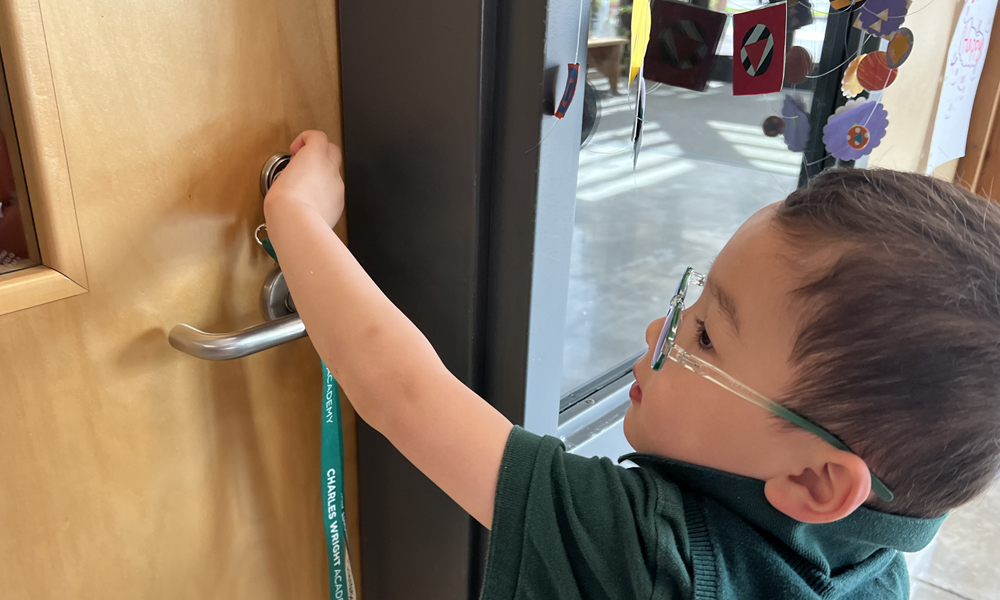The Making of a “Study” in Preschool
How Faculty Participate as Co-Learners with Children
By Rixa Evershed, Beginning School Director
Our Preschool classroom recently embarked upon a study of locks and keys. The word “study” can be interchanged with unit, investigation, or inquiry. A “study” is being immersed in the concepts, the materials and the curiosity that drives a child to look deeper. These studies incorporate ideas from each of our guiding documents as well as consider children’s curiosity and the ways that the Portrait of a Tarrier will show up in their lives.
During their time with children, faculty spend time listening and observing the topics and materials in which the children are engaged. They document words used, questions asked, and the topics that emerge. They also pay close attention to the materials in which children show interest. One such topic is keys. Most of the faculty and administration wear their keys. From the beginning of the school year, children showed a deep curiosity about all things locks and keys. Daily, they would question all available adults about their keys and what they unlocked. Teacher Avery recognized that this was something she wanted to present as a study for the children, “I always create a map of what I think they will be interested in and paths of inquiry they may pursue. I truly thought that they would be interested in the mechanics of locks. It turned out not to be the case.”
Teacher Avery shared her idea with the children and presented the locks for study. Every study is specifically designed to reflect children and their interests. We want every child to feel seen and feel a sense of belonging within the community. As soon as Teacher Avery was done presenting the study, Steven came up to her and said, “You know that this is something I love, right?”
Studies have a continuum of skills embedded in the investigation of materials designed to provoke questions. The “Lock Walk” around the Lower School created opportunities for children to collaborate, investigate, show what they knew, and follow the lead of a colleague. Steven was the ‘foreman’ for the lock walk. He was in charge of gathering all of the data the children collected on the walk. As they walked around the school, the children would check in with Steven, sharing the information that they gathered. Teacher Avery shared, “I thought there would be conflict. There wasn’t. The children really showed how deeply they ‘see’ each other. They knew this was important to Steven and they honored that.” Teacher Skylynn was thoughtful as she reflected, “They were so engaged, calling each other over to determine whether or not what they found was a lock. I realized how observant they are, seeing locks I wouldn’t have noticed.” Teacher Laura laughed, “The children taught me about hex keys—I had no idea.”
Teacher Skylynn also shared how impacted her pedagogy was by the ways the children retained their knowledge of the vocabulary and concepts that had been presented. “Their dramatic play was so rich. They had so many scenarios that they were acting out. By presenting the materials without specific instructions, they were able to apply the materials to their research in a way that was meaningful to them.” Teacher Avery added, “They weren’t interested in the mechanics as I thought they would be. They were more invested in the things that locks could protect and keep safe.”
Throughout the year, our faculty have engaged as learners alongside the children. Each one is working on ways to document children’s interests and learning in a way that reflects each child as a fully participating, and vital community member. They share their “wonders” with each other and the research they do and answers they find will inform next steps in the classroom.
Creating connections to knowledge about the world around them is one of the primary goals of an early childhood classroom. We want children to have a rich understanding of their community, to know themselves and each other. Each day in our 3s classroom, children share their take-aways. They reflect with each other and our faculty about concepts, curiosities, and the research they are engaged in. They are learners.
“The connections that the children made with each other, the materials, the joy that they had on their faces. Each child was fully engaged in the work. They were all in it in different ways. Some really were focused on the art, others on the mechanics, and all of the dramatic play was so cool. I have discovered that their voice in the class needs to be the loudest one.”

“I truly thought that they would be interested in the mechanics of locks. It turned out not to be the case.” – Teacher Avery


